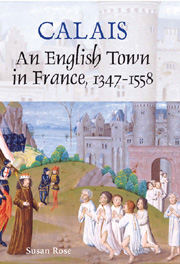
De Re Militari | Book Reviews
Susan Rose
Calais, An English Town in France, 1347-1558
Woodbridge: The Boydell Press, 2008. 187 pp. £50.00/$95.00 USD. ISBN 978 1 84383 401 4.

As mentioned in the précis, Susan Rose’s main goal for her book is to isolate the story of Calais under English governance and to trace its history, in both political and military narrative and economic progression, from its capture by the English in 1347 during the early stages of the Hundred Years War until its surrender to the French in 1558. To this end, her endeavor has been a success. Attempting to debunk assertions by earlier historians that Calais served little purpose for the English during these two centuries of possession other than prestige while simultaneously creating a tremendous financial burden for the English by its maintenance, Rose argues that Calais played an important role both diplomatically and economically for the English, even if its militarily strategic significance can rightfully be questioned. Indeed, not only has she taken pains to illustrate the financial contribution and advantages provided by locating the wool Staple at Calais, but she has also demonstrated how Calais was pivotal for English political intrigue, serving as a base for factional support, particularly during the Wars of the Roses and the conflict between reformers and Catholics under Henry VIII, Edward VI and Mary I.
Organized essentially chronologically into nine chapters with a short introduction and conclusion, Calais follows the important narrative of the city’s existence under English rule, focusing primarily on the political and military timeline with a healthy sprinkling of economic details. In addition, Rose has devoted two main chapters, and significant portions of others, to the Calais wool Staple, discussing it in large part by examining the lives of leading merchant families involved with the Staple, such as the Celys and Pastons in the fifteenth century, and the Lisles and Johnsons in the sixteenth. In fact, the development and role of the Staple in the everyday life, economy and political status of Calais is a crucial theme running through the entire book, and at times the reader wonders whether a close scrutiny of the Staple was actually intended to be the primary focus of the work. The bulk of the text is devoted to the fourteenth and fifteenth centuries; the chapter on the early Tudors, by comparison, occasionally feels quite rushed and the reader is left feeling that there is material that was omitted or glossed over.
Rose exhaustively mines information in certain documentary evidence, such as the Lisle letters or Johnson papers, as well as documents contained within archives such as the British Library and the National Archives in London, to pinpoint issues particularly affecting the story of English Calais. Additionally, she utilizes many primary source excerpts reproduced in other works. The bibliography, while not staggeringly comprehensive, contains a good balance of primary and secondary sources, including the standard authoritative works, and illustrates the fact that Rose is capable of working with multilingual sources; secondary sources in French are as numerous as those in English.
Calais is written in lively prose and flows easily. A relatively short book, at fewer than 200 pages, it makes for a quick and cohesive read. There are few illustrations, the great majority of which pertain to sixteenth-century Calais and thus are concentrated within the last third of the book; however, the most useful image is the map at the beginning of the book which shows the major cities, towns and castles of Calais and the boundaries of the Pale based on a survey of 1536. During discussions of the military movements in and around Calais during the Hundred Years War, additional maps would have been helpful, particularly for those who are better served by visual depictions of military strategies than by text alone. Ultimately, however, Calais is not a book that attempts to wow its audience with a splashy pictorial display, but rather with good solid text. As a result, it is not a book geared towards those with a casual interest in history, but rather those for whom a more specific investigation into the minutiae of the city’s history and functions holds appeal. That quotes in Middle French and Middle English are often included without translation, which assumes the reader’s comfort with medieval languages, as well as the frequent allusion to different medieval coinages without explanation, additionally points towards a more specialized and scholarly intended audience. And it is this audience that will find Calais to be a useful source, one that presents a continuous, if sometimes perhaps unevenly focused, narrative of Calais’ history under English governance.
